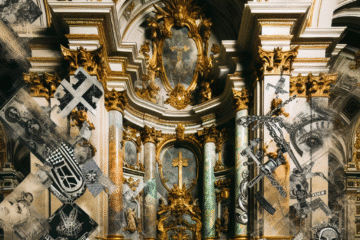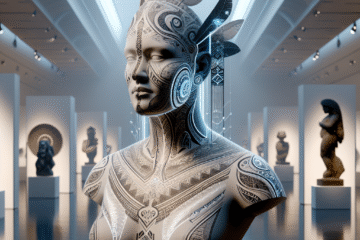
Image title: The Birth of the Virgin
Medium: Tempera and oil on wood
Date: 1467
Source:
The Met Collection
“
With every experience, you alone are painting your own canvas, thought by thought, choice by choice.
”
— Oprah Winfrey
Painting with Light: Indigenous Australian Art’s Dialogue with Optical Physics
Introduction: Light, Land, and Legacy
At first glance, the intricate patterns of Indigenous Australian dot painting might appear abstract or decorative. But peer deeper, and what emerges is a profound dialogue with light, environment, and perception itself. Long before modern scientists articulated the principles of optical physics, Aboriginal artists were using pigment and technique to map the environment, convey cosmology, and even anticipate principles of light interaction that we now associate with diffraction and visual acuity. This article explores how Indigenous Australian art—particularly the dot painting tradition—embodies deep knowledge systems that resonate with both ancient Dreamtime stories and contemporary understandings of visual science.
Chapter 1: Dreamtime as a Visual Cosmology
Dreamtime stories—central to Aboriginal spiritual life—are not mere myths but blueprints for understanding existence. Every element in these narratives encodes knowledge about geography, flora and fauna, moral conduct, and natural phenomena. In art, these stories are often translated into highly stylized visual maps. Dot painting, widely practiced since the 1970s but rooted in much older sand, body, and bark designs, offers a synesthetic experience—a way of seeing and feeling stories in visual form. Dotting was initially used as a form of “sacred obfuscation,” hiding meanings from outsiders. But the visual texture it established also allowed the eyes to engage in micro-perceptual shifts, subtly altering as the viewer moves—an effect akin to optical vibration seen in modern art and science.
Chapter 2: The Optics of Dot Painting
Dotting techniques mimic certain principles of optical physics. The repetition of contrasting pigments—white, ochre, red, black—contributes to an almost shimmering surface, triggering afterimages and visual illusions. These effects arise from how the human eye processes clusters of light and dark, a principle also observed in Pointillism and Op Art centuries later. But unlike Seurat’s chromatic experiments, Aboriginal dot painting doesn’t just play with color theory—it narrates spatial relationships. The dots simulate the diffusive scattering of light on sand, bark, and rock, mimicking how light interacts with landscapes. In effect, dot painting becomes a kind of “ocular cartography”—a painted language of perception.
Chapter 3: Environmental Mapping through Light
One of the most compelling aspects of Indigenous dot painting is its function as a map—not just directional but ecological. Songlines and Dreaming tracks are encoded into these paintings, often guiding the viewer through stories and terrains simultaneously. Dots and strokes can represent waterholes, paths, animal tracks, or spiritual waypoints. But they also emulate how heat rising from hot ground blurs vision, or how moonlight shivers across desert grasses. By layering these effects, Aboriginal artists reveal a phenomenological understanding of how land is seen and felt under changing light conditions. This aligns with how contemporary optical sensors now model environments: data rendered through shifts in luminance and points of pixel data—not too different from the logic of the dot.
Chapter 4: Transformation and Exchange
While deeply rooted in tradition, Aboriginal dot painting underwent a major transformation in the Papunya Tula movement of the 1970s, when artists like Clifford Possum and Kaapa Tjampitjinpa began transferring ceremonial designs onto canvas. This era marked a cross-cultural evolution, where Indigenous epistemologies met Western art markets. Dots became not only spiritual conveyors but also bridges between worlds—informing abstraction, modernism, and intercultural aesthetics. These works challenged notions of authorship, geometry, and materiality in art. Moreover, they were unknowingly resonating with contemporary scientific discussions around systems theory, visual encoding, and perception.
Chapter 5: Contemporary Resonances and Future Dialogues
Today, Aboriginal art continues to inspire not only cultural preservation but also scientific curiosity. Interdisciplinary efforts are exploring how the visual grammar of dot painting might inform studies in perception, augmented reality, and data visualization. Meanwhile, artists like Emily Kame Kngwarreye and Daniel Walbidi push the medium into new visual realms, blending traditional knowledge with global artistic language. Their works suggest that Indigenous Australian art is not static tradition but a dynamic system—one that understands light not only as a physical property but as spiritual matrix, instructional tool, and aesthetic force. In this light (quite literally), dot painting is both science and story, a cultural technology as sophisticated as any algorithm.
Conclusion: Seeing with Knowledge
Ultimately, Indigenous Australian dot painting invites us to reconsider how art encodes knowledge. These dotted forms are more than decoration—they are algorithms of light, emotion, and place; they are meditations on the seen and unseen. As we deepen our understanding of optics and visual perception in the sciences, looking back to these ancient traditions might illuminate ways of seeing and knowing that the West has only recently begun to understand.

Image description:
‘Fungal Dot Painintgs’ creates results similar to the pointilism art technique ,althoug hthe living fungus (in this case, the mould Aspergillus niger) allows for a more dynamic artform. From Grunwald et al (2021), Journal of Fungi, 7(12), 1018
License:
CC BY-SA 4.0
Source:
Wikimedia Commons
Useful links:


